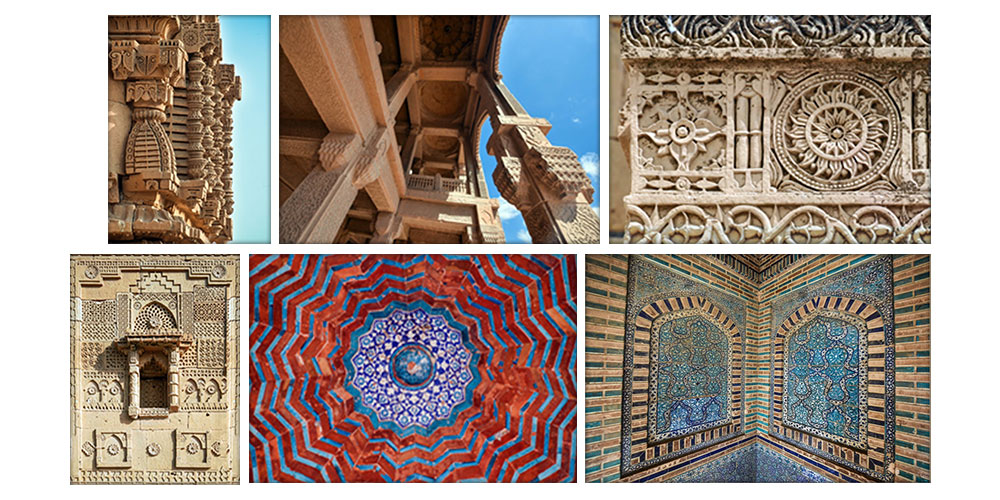ZULFIQAR ALI ZULFI’S HUES OF DUSK
- 29 Oct - 04 Nov, 2022
The latest exhibition created and displayed at the Mohatta museum is the spectacular construction of the Makli monuments located in Thatta. Gazing at the incredibly beautiful works, one is aware of the history of Pakistan, its many beautiful, historic sites throughout the land.
Walking from hall to hall in the Mohatta Palace, it appears that the walls are solid and the intricate work carved and moulded from brick and stone, but on closer examination one discovers it is all created from superb photography, a spectacular professional job of creating the monuments.

One is aware of so many historic sites throughout the country, many neglected and overlooked. Exploring the work of the Makli structures, one was reminded that Mehergar in Balochistan was the first place in the world where a colony of people settled and started a community, but as yet there is no museum in the vicinity.
Makli is one of the six world heritage sites in Pakistan, which the Mohatta Palace informs us, was once a small settlement on the river Indus. Visiting the opening of the exhibition was an exciting affair, and several artists were there to exclaim over the work of the decorative styles and ornamentation in brick and stone that are so beautiful.
One was tempted to visit the exhibition alone in the afternoon to wander at will and explore in depth the ornamentation of the structures.
Visiting the actual site in the past, one discovers it was spread over an area of some 10 square kilometers and houses approximately between 5000,000 to one million tombs, built over the course of 400 years. One discovers several large monuments in memory of royalty, distinguished scholars and sufi saints.
In 1981, the site was inscribed as a UNESCO World Heritage site.
Quoted as: “an outstanding testament to Sindh civilisation between the 14th to 18th centuries. The history begins with the sufi saint, poet and scholar; Shaikh Jamali who established a sufi gathering there and is buried at Makli. The history continues tha the 14th century ruler; Jam Tamachi venerated the saint and whished to be buried near him. Then we are informed to the beginning of the tradition of using Makli as a funery site.
There was considerable information to fascinate visitors and answer questions at the Mohatta Palace. From the objects and buildings shown, one was able to explore the gravestones finely carved with floral and geometric ornamentation. The headstones divided into compartments with linking patterns.
As the Mohatta details informed visitors, “The pillars, walls projections, panels and surfaces are carved with linear patterns, while lintels support friezes of qur’anic instriptions, surfaces are further divided into panels, bands of chain motifs with rosettes, half and full lotuses, arches set with sunflowers, honey comb patterns, and arabesques..
Exploringe a detail from the wall of Jam Nizamuddin’s maseoleum, Makli reflects a heritage of superb craftsmanship made with the best clay. They ring like metal and break clean as glass. The enameled bricks are elegantly set in patterns and are conspicuous for their columnar enamel tiles that are lavishly used in dandos and spandrels.”
Artists viewing the work were very impressed and intrigued.
The Mohatta Palace had also considerable material on the history of the subject. It has obviously been a thoroughly investigated and explored subject, taking considerable time and patience, as well as superb photography.
Visiting the exhibition, I found myself hoping it would be there for the next Karachi Biennale. Unfortunately, many historic sites have not been given enough appreciation in the country.
One remembers artist Nahid Raza’s first work of note was based on the `Chawkandi Tombs’, in the early 1980’s. Taking her children along for picnics, she explored and painted the incredible pieces. Her work on these tombs was acclaimed and encouraged people to drive out and view the work.
This went on, until in spite of all the space available, a factory attracting numerous flies was opened near the Chawkandi Tombs and visitors were put off.
One must visit the Mohatta Palace with time to explore, gallery 1, gallery 2a and gallery 2b, the tomb of the ‘noblest samma ruler, Jam Nizamuddin’.
One hopes that many schools may take their pupils on a visit to the Mohatta Palace, and I implore the board of trustees to kindly keep the exhibition on in time for Karachi’s next bienalle. •
COMMENTS